
The Green River is a 384-mile-long (618 km) tributary of the Ohio River that rises in Lincoln County in south-central Kentucky. Tributaries of the Green River include the Barren River, the Nolin River, the Pond River and the Rough River. The river was named after Nathanael Greene, a general of the American Revolutionary War.

The Alabama cave shrimp is a species of shrimp in the family Atyidae, found only in caves in the state of Alabama.

The conservation status of a group of organisms indicates whether the group still exists and how likely the group is to become extinct in the near future. Many factors are taken into account when assessing conservation status: not simply the number of individuals remaining, but the overall increase or decrease in the population over time, breeding success rates, and known threats. Various systems of conservation status exist and are in use at international, multi-country, national and local levels as well as for consumer use.

Driftless Area National Wildlife Refuge is a United States National Wildlife Refuge in northeastern Iowa, southwestern Wisconsin and northwestern Illinois. It is a non-contiguous collection of parcels in the vicinity of the Upper Mississippi River National Wildlife and Fish Refuge.
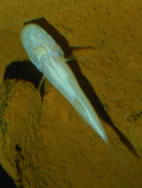
The Alabama cavefish is a critically endangered species of amblyopsid cavefish found only in underground pools in Key Cave, located in northwestern Alabama, United States in the Key Cave National Wildlife Refuge. It was discovered underneath a colony of gray bats in 1967 by researchers Robert A. Kuehne and John E. Cooper and scientifically described in 1974.
Threatened arthropods are defined here as any of a number of species within the phylum Arthropoda, whose extinction is likely in the foreseeable future. Estimating the number of threatened arthropod species is extremely difficult, primarily because a vast number of the species themselves are not yet named or described. Furthermore, according to Deyrup and Eisner, "The rate of destruction and degradation of natural habitats is currently so great that there are not nearly enough biologists to even catalog the arthropod species that are suddenly on the edge of extinction." In any case, independent estimates indicate that there are millions of undocumented arthropods on Earth.

Cumberlandia monodonta is a freshwater mussel endemic to the United States. Currently, C. monodonta is listed as an endangered species by the U.S. Fish and Wildlife Service and the International Union for Conservation of Nature.

Linderiella occidentalis is a species of fairy shrimp native to California. It is a small crustacean in the family Chirocephalidae family. It has a delicate elongated body, large stalked compound eyes, no carapace, and eleven pairs of swimming legs. It glides gracefully upside down, swimming by beating its legs in a complex, wavelike movement that passes from front to back. Like other fairy shrimp, L. occidentalis feeds on algae, bacteria, protozoa, rotifers and detritus.
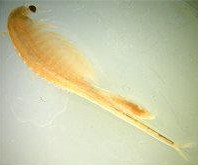
The conservancy fairy shrimp is a small crustacean in the family Branchinectidae. It ranges in size from about 1.25 centimetres (0.49 in) to 2.5 centimetres (0.98 in) long. Fairy shrimp are aquatic species in the order Anostraca. They have delicate elongate bodies, large stalked compound eyes, no carapaces, and eleven pairs of swimming legs. They glide gracefully upside down, swimming by beating their legs in a complex, wavelike movement that passes from front to back. Fairy shrimp feed on algae, bacteria, protozoa, rotifers and detritus. This species is endemic to California in the United States.
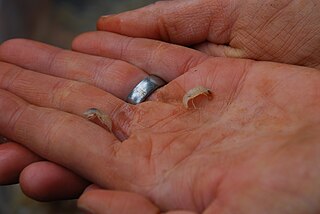
The Madison Cave isopod, Antrolana lira, is a freshwater, cave-dwelling crustacean species. It is in the family Cirolanidae and it is the only species of its genus Antrolana. This isopod can be found in flooded limestone caves and karst aquifers throughout the Great Appalachian Valley of Virginia and West Virginia. The Madison Cave isopod has been listed as a vulnerable species on the IUCN Red List since 1983 and as a threatened species under the United States Endangered Species Act since 1982. The species was named after the cave in which it was first discovered, Madison Saltpetre Cave. Very little is known about the life history and behavior of the Madison Cave isopod.
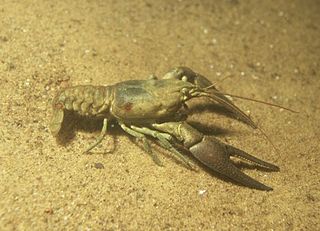
Cambarus aculabrum is a rare species of cave-dwelling crayfish known by the common name Benton county cave crayfish. It is native to Arkansas in the United States, where it is known from only four locations. It is a federally listed endangered species of the United States.
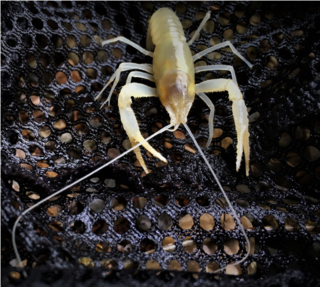
Cambarus zophonastes, also known as the Hell Creek Cave Crayfish, is named for its original location of discovery, Hell Creek Cave. It is also found in other similar habitats in Stone County and Marion County, Arkansas. These habitats include springs and caves such as Nesbitt Spring Cave in Stone County. C. zophanastes is critically endangered according to the IUCN. C. zophanastes is also protected by the ESA as an endangered species. Currently conservation efforts focus on monitoring populations, reducing disturbances, and monitoring water quality. More research has to be conducted to better understand and conserve the species.
Palaemonetes antrorum, also known as the Balcones cave shrimp and the Texas cave shrimp, is a species of palaemonid shrimp endemic to Texas. It is listed as an endangered species on the IUCN Red List, and as a Species of Concern by the United States Endangered Species Act.

Palaemonetes cummingi, known as the Squirrel Chimney cave shrimp or the Florida cave shrimp, is a threatened species of cave-dwelling shrimp in the family Palaemonidae. P. cummingi has been observed in one sinkhole called Squirrel Chimney in Alachua County, Florida near Gainesville. Although exact numbers are unknown, it is speculated that the current P. cummingi population is very small.

The genus Palaemonias comprises two species of endangered, albinistic, obligate cave shrimp:

The Big Sandy crayfish, Cambarus callainus, are freshwater, tertiary burrowing crustaceans of the family Cambaridae. They are found in the streams and rivers of Appalachia in Virginia, West Virginia, and Kentucky, in what is known as the Big Sandy watershed. Populations are often mistaken with Cambarus veteranus, but morphological and genetic data suggests that these are separate taxa; however, both are protected under the Endangered Species Act. There is very little information available on the Big Sandy crayfish because it is a relatively new species.

The spring pygmy sunfish, Elassoma alabamae, is a species of pygmy sunfish endemic to springs in northern Alabama. It was historically known to occur in springs in North Alabama along the Tennessee River in Limestone and Lauderdale counties. The spring pygmy sunfish was first discovered in Cave Spring in Lauderdale County, Alabama in 1937 but in 1938, this site was flooded by the creation of the Pickwick Reservoir. The spring pygmy sunfish was considered extinct until its rediscovery in the Beaverdam Spring complex in 1973 by researchers from the University of Tennessee.
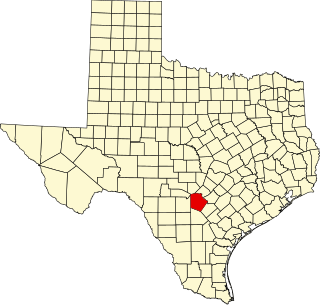
Rhadine infernalis is a species of troglobitic beetle of the family Carabidae. They are endemic to the county of Bexar, Texas. Within this county, R. infernalis has been found in 39 caves. There are 2 named subspecies of R. infernalis: R. infernalis infernalis and R. infernalis ewersi. There is a third possible subspecies that has not been officially described. R. infernalis was classified in 2000 as endangered under the IUCN Endangered Species Act of 1973, along with 8 other karst invertebrates in the same region. It has the widest known range of the endangered karst invertebrates.
Batrisodes venyivi, also known as Helotes mold beetle, is an eyeless beetle in the family Staphylinidae. They are found exclusively in the dark zones of caves in the Southwest region of Texas. More specifically, they have been found in eight caves throughout Bexar County, Texas. Similar species include the eight other Bexar County invertebrates, such as Rhadine exilis or Rhadine infernalis. All nine of these species are protected under the Endangered Species Act. Despite the efforts of a small number of researchers, the logistical challenges of accessing this habitat greatly limit the amount and type of information. Very little is known of the species’ behavior, population trends, or general ecology.

















